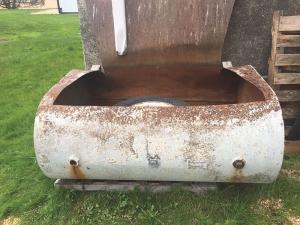2017 - Volume #41, Issue #4, Page #35
[ Sample Stories From This Issue | List of All Stories In This Issue | Print this story
| Read this issue]
He Dunks Tires In Rain Water To Check For Leaks
 |
The converted home heating oil tank is located next to the shed just below a downspout. It’s mounted on some wooden pallets, making it easy to move around with a skid loader and also eliminating the need to bend over.
Burtard removed the tank’s legs and then laid it on its side and cut a big U-shape opening in the top. He folded the cut piece of metal back to form a backsplash and bolted it to the shed wall. “I’ve used this idea for several years and it works surprisingly well. I’ve even modified some tanks for friends,” says Burtard. “The tank fills automatically whenever it rains, all summer long. I built it because I don’t like to spend money at a tire shop if I don’t have to. A lot of tire shops nowadays don’t bother dunking tires in water any more to find leaks, and instead just squirt soapy water onto the tire. Then if they can’t see any bubbles they say you need a new tire.
“Placing a tire under water makes it easy to see where the air leak is because bubbles will start coming out right away. I can immediately tell whether it’s a leaky valve stem or core or a bent wheel rim or a staple in the tire tread. If the leak is in a small wheelbarrow tire, sometimes I just add a little drained motor oil to plug the leak. I also use drained motor oil on rusty or corroded aluminum rims. The oil keeps the aluminum from corroding. I clean the rim and then smother it with the oil, which softens up the rubber and makes a nice seal.”
Burtard says he usually keeps the tank a little more than half full of water. He made an overflow adjustment device by installing a 90-degree elbow and a 12-in. length of straight pipe in the tank’s oil drain hole. “This way when I dump a tire into the water it overflows behind the tank and not onto my feet,” he says.
He plans to use a vehicle’s rack and pinion steering system to push the tire down into the water, eliminating the need to push the tire down by hand for bubble inspection. “It’s hard to hold the tire steady while you’re looking at the water to look for bubbles, especially if it’s a big tire,” says Burtard. “I’ll add a steering wheel to the pinion and also weld a big steel plate to the end of a pipe that I’ll attach to the pinion. Cranking on the steering wheel will push the tire down into the water.”
Contact: FARM SHOW Followup, Kenneth J. Burtard, W660 County Road DD, Theresa, Wis. 53091 (ph 920 251-2726; kenburtard@icloud.com).

Click here to download page story appeared in.

Click here to read entire issue
To read the rest of this story, download this issue below or click here to register with your account number.




